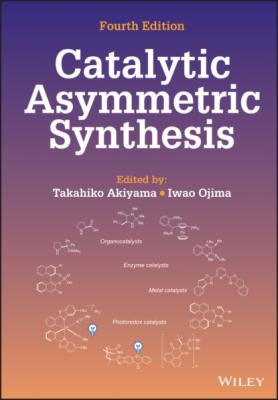Catalytic Asymmetric Synthesis. Группа авторов
Чтение книги онлайн.
Читать онлайн книгу Catalytic Asymmetric Synthesis - Группа авторов страница 45
 alt="Schematic illustration of diels–Alder reaction between cyclopentadien and enals (a), and cyclopentadienone (b) using IDPi."/>
alt="Schematic illustration of diels–Alder reaction between cyclopentadien and enals (a), and cyclopentadienone (b) using IDPi."/>
Scheme 2.35. Diels–Alder reaction between cyclopentadien and enals (a), and cyclopentadienone (b) using IDPi (
Source: Based on [85]).
Numbers of enantioselective Diels‐Alder reactions have been reported, but reactions with unbiased benzoquinones have remained a formidable challenge. Masson developed the Diels‐Alder reaction between quinone and diene carbamate to afford dihydronaphthalene‐1,4‐diols catalyzed by SPINOL‐derived CPA 13c (Scheme 2.36a) [86]. Simply changing the amount of quinone resulted in the selective formation of the redox isomers with high stereoselectivity (Scheme 2.36b).
Scheme 2.36. Redox‐divergent Diels‐Alde reaction leading to dihydronaphthalene‐1,4‐diols (a) (
Source: Based on [86]
), and redox isomers (b).
In order to generate a stronger chiral Brønsted acid, Ishihara employed a BBr3‐CPA 6m complex that is expected to function as Lewis acid‐assisted Brønsted acid (LBA) [50], to promote the Diels‐Alder reaction between α‐substituted acroleins and 1,2‐dihydropyridines, which gave cycloadducts with 92–98% ee (Scheme 2.37, Figure 2.9) [87].
Scheme 2.37. Diels‐Alder reaction promoted by Lewis acid‐assisted Brønsted acid.
Source: Based on [87].
Figure 2.9. Lewis acid‐assisted chiral Brønsted acid.
Source: Based on [87].
2.4.2. Aza‐Diels‐Alder Reactions
The Povarov reaction is an inverse electron‐demand aza‐Diels‐Alder reaction and 2‐azadiene and electron‐rich alkenes. Akiyama reported the Povarov reaction between aldimine bearing a 2‐hydroxyphenyl group on nitrogen and electron‐rich alkene using CPA 6h in 2006 (Scheme 2.38a) [88]. Although presence of the 2‐hydroxyphenyl group on nitrogen was critical for the Povarov reaction, Zhu and Masson reported a three‐component Povarov reaction using enecarbamates as dienophiles catalyzed by 12a (Scheme 2.38b) [89, 90]. Use of the 2‐hydroxyphenyl group was obviated. The mechanism of the Povarov reaction is shown in Figure 2.10. Whereas phosphoryl oxygen formed a hydrogen bond with the 2‐OH moiety in the reaction reported by Akiyama, Zhu and Masson proposed that phosphoryl oxygen would form a hydrogen bond with the N‐H moiety of the enecarbamate.
Scheme 2.38. Povarov reaction with N‐2‐hydroxyphenyl imine (a) (
Source: Based on [88]
) and N‐phenyl imine (b) (
Source: [89, 90]).
Figure 2.10. Transition state model of the aza‐Diels‐Alder reaction.
Masson subsequently reported intramolecular Povarov reactions catalyzed by 6e (Scheme 2.39) [91]. Imines were generated in situ from aldehydes and o‐hydroxyaniline.
Scheme 2.39. Intramolecular Povarov reaction of azadiene.
Source: [91].
Huang succeeded in the construction of tetrahydroquinolines bearing two quaternary stereogenic centers by the reaction between two types of aniline derivatives and pyruvate catalyzed by CPA 12b (Scheme 2.40) [92]. The Mannich reaction and the subsequent Friedel‐Crafts cyclization gave C2‐quaternary carbon centers. “Hybrid” Povarov products were obtained from aniline pairs.
Scheme 2.40. Povarov reaction leading to tetrahydroquinoline with two quaternary stereogenic centers.
Terada reported a hetero‐Diels‐Alder reaction between azopyridine carboxylate and amidodienes by developing a novel chiral carboxylic acid‐monophosphoric acid 26 (Scheme 2.41) [93].
Scheme 2.41. Hetero‐Diels‐Alder reaction between azopyridine carboxylate and amidodienes.
Source: Based on [93].
Schneider reported a hetero‐Diels‐Alder reaction between enamides and in situ generated aza‐o‐quinone‐methide, giving rise to tetrahydroacridines using CPA 6n [94]. Subsequent transformation gave free hexahydroacridines with a total of three new stereogenic centers (Scheme